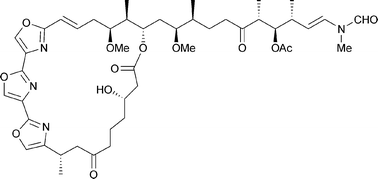A new, second generation, total synthesis of ulapualide A (1), whose stereochemistry was recently determined from X-ray analysis of its complex with the protein actin, is described. The synthesis is designed and based on some speculation of the biosynthetic origin of the contiguous tris-oxazole unit in ulapualide A, alongside that of the related co-metabolites that contain only two oxazole rings, e.g.6 and 7. The mono-oxazole carboxylic acid 67b and the mono-oxazole secondary alcohol 55b which, together, contain all of the 10 asymmetric centres in the natural metabolite, were first elaborated using a combination of contemporary asymmetric synthesis protocols. Esterification of 67b with 55b under Yamaguchi conditions gave the ester 77 which was then converted into the ω-amino acid 18a following simultaneous deprotection of the t-butyl ester and the N-Boc protecting groups. Macrolactamisation of 18a, using HATU, now gave the key intermediate macrolactam 17, containing two of the three oxazole rings in ulapualide A (1). A number of procedures were used to introduce the third oxazole ring in ulapualide A from 17, including: a) cyclodehydration to the oxazoline 78a followed by oxidation using nickel peroxide leading to 76; b) dehydration to the enamide 79, followed by conversion into the methoxyoxazoline 78b, via80, and elimination of methanol from 78b using camphorsulfonic acid. The tris-oxazole macrolide 76 was next converted into the aldehyde 82b in four straightforward steps, which was then reacted with N-methylformamide, leading to the E-alkenylformamide 83. Removal of the TBDPS protection at C3 in 83 finally gave (−)-ulapualide A, whose 1H and 13C NMR spectroscopic data were indistinguishable from those obtained for naturally derived material. It is likely that the tris-oxazole unit in ulapualide A (1) is derived in nature from a cascade of cyclodehydrations from an acylated tris-serine precursor, e.g.9, followed by oxidation of the resulting tris-oxazoline intermediate, i.e.10. It is also plausible to speculate that the biosynthesis of metabolites related to ulapualide A, e.g. the bis-oxazole 6 and the imide 7, involve cyclisations of just two of the serine units in 9. These speculations were given some credence by carrying out pertinent interconversions involving the bis-oxazole amide 24, the enamide 25, the imide 26, the oxazoline 27 and the tris-oxazole 30 as model compounds. An alternative strategy to the tris-oxazole macrolide intermediate 76 was also examined, involving preliminary synthesis of the aldehyde 73, containing a shortened (C25–C34) side chain from 67b and 47b. A Wadsworth–Emmons olefination reaction between 73 and the phosphonate ester 74 led smoothly to the E-alkene 75, but we were not able to reduce selectively the conjugated enone group in 75 to 76 without simultaneous reduction of the oxazole alkene bond, using a variety of reagents and reaction conditions.


 Please wait while we load your content...
Please wait while we load your content...